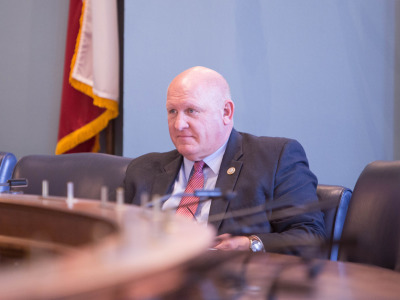For as much trouble as lawmakers are having agreeing on whether to keep the government from shutting down Oct. 1, things aren’t moving any faster with the farm bill, parts of which start expiring Sept. 30.
The House and Senate Agriculture committees have yet to agree on how to bolster commodity programs in a new farm bill. The committees are still awaiting cost estimates on various proposals for addressing Price Loss Coverage reference prices, and it’s still far from clear how lawmakers will pay for increasing them.
Meanwhile, Senate Agriculture Committee Chairwoman Debbie Stabenow, D-Mich., and Agriculture Secretary Tom Vilsack are frustrating Republicans by insisting that Congress leave climate-related guardrails on $18 billion in conservation funding provided through the Inflation Reduction Act. Under the IRA, the money is restricted to subsidizing climate-smart farming practices; Republicans would like to bring the money into the farm bill and remove the climate-related restrictions.
Stabenow said at a Bipartisan Policy Center event Tuesday that lawmakers still need to find ways to pay for needs in the bill that will have bipartisan support.
“The farm bill is the art of the doable. And we still have folks talking about things that are just going to cost more votes than they get,” she said.
Stabenow has gotten some funding help from Vilsack, who is using his Commodity Credit Corporation authority to put $1.4 billion into market promotion, but other challenges remain. Stabenow said Tuesday she had talked to Senate Majority Leader Charles Schumer, D-N.Y., about additional ways to fund the farm bill but didn’t say whether those discussions had borne fruit.
In the House, the ongoing turmoil among House Republicans over funding the government when the fiscal year ends Sept. 30 will likely delay consideration of a farm bill until at least November, House Agriculture Committee Chairman Glenn “GT” Thompson, R-Pa., told reporters Tuesday.
 House Ag Chair Glenn 'GT' Thompson, R-Pa.
House Ag Chair Glenn 'GT' Thompson, R-Pa.Some Republicans have been openly predicting the government will shut down for some time in October; even if lawmakers do agree on a temporary funding bill in the coming days it could be for only a few weeks at most.
“I’m probably more comfortable with us looking in November for floor time for the farm bill,” Thompson told reporters.
Thompson said he’s still waiting on cost estimates for various ideas for raising PLC reference prices, but he acknowledged that an across-the-board increase is unlikely, indicating that he preferred more targeted increases that would vary by commodity.
“I’ve always wanted to believe that you should do what you need, not what you want, and some commodity prices have come up. Others have stayed low,” Thompson said.
Thompson’s committee appealed to the House Budget Committee in March for more funding for the farm bill, but a fiscal 2024 budget resolution that the committee will consider Wednesday doesn’t earmark any new money for the bill, despite a policy statement calling for the Ag Committee to “improve and strengthen the Farm Safety Net.”
The GOP budget blueprint also wouldn’t require any cuts in farm bill spending. “I think it helps us actually because there’s a very clear statement that says, there’ll be no cuts to agriculture,” Thompson said.
The top Democrat on the House Ag Committee, David Scott of Georgia, saw it differently.
“This budget does nothing to ensure the continued viability of American agriculture or address the needs that the House Agriculture Committee outlined in its bipartisan letter earlier this year to the House Budget Committee to help it write a farm bill, Scott said in a statement. “Instead, it shortchanges the farm bill, focuses on tax cuts for the rich, and undermines the bipartisan work we do on the House Agriculture Committee every day.”
In any case, it’s not clear the measure can get the votes to pass the House.
Stabenow reiterated Tuesday that she would like to bring the IRA conservation funding into the farm bill, because budget rules would allow it to be used to permanently increase funding levels for conservation programs. But she continued to insist that the money stay in conservation programs and be devoted to climate-related purposes.
“What we will not do, what I will not do, is put the money without the focus on climate over into the (farm bill) baseline. That would be moving us backwards,” Stabenow said.
Vilsack staked out the same position during a recent appearance at the Farm Progress Show in late August.
“We’ve got a lot more that can be done and needs to be done; the challenge is making sure that nobody decides to redirect those resources away from the use that they were intended under the IRA,” Vilsack said.
The Republican staff on the Senate Agriculture Committee responded with a blog post arguing the climate restrictions on the IRA funding are leaving out a lot of needs in farming country. The IRA funding is devoted to climate-smart farming practices.
 Ag Secretary Tom Vilsack addresses reporters at the 2023 Farm Progress Show in Illinois.
Ag Secretary Tom Vilsack addresses reporters at the 2023 Farm Progress Show in Illinois.According to the GOP post, 51% of the funding USDA distributed through the Environmental Quality Incentives Program and Conservation Stewardship Program in 2020 through 2022 was earmarked for practices that wouldn’t qualify as climate-smart.
Don't miss a beat! Sign up for a FREE month of Agri-Pulse news! For the latest on what’s happening in agriculture in Washington, D.C. and around the country, click here.
USDA is making the case that there is heavy demand for the IRA funding, even with the restrictions. As of August, for example, the department had received $308 million in applications from farmers for $174.5 million in IRA funding that is available for EQIP in fiscal 2023, according to a Natural Resources Conservation Service slide presentation obtained by Agri-Pulse.
NRCS has received $2.2 billion in applications for the Regional Conservation Partnership Program, far more than the $500 million available for RCPP in FY23 through either through the IRA or through funding in the expiring 2018 farm bill.
During a recent conference call with conservation program advocates, NRCS officials indicated they would be expanding the number of practices that will be eligible for IRA funding, said Ferd Hoefner, a policy consultant.
A spokesman for Senate Ag Republicans, Patrick Creamer, said that the demand for the IRA funding doesn’t address the GOP senators’ concerns.
“The debate surrounding moving IRA funds into the farm bill is not about concern over USDA’s ability to spend those dollars or demand for these programs. It is about whether Congress can agree to bring unobligated funds into the permanent baseline in a bipartisan manner so that all farmers have the opportunity to access all practices to help meet their unique conservation needs and achieve our shared goals,” Creamer said.
“The demand for these programs would exist if they stayed in the IRA with the current climate requirements, or if these funds were moved into farm bill program and opened up to all practices,” Creamer said.
Bruce Knight, a conservation policy consultant who served as chief of NRCS during the George W. Bush administration, said he believes part of the demand for RCPP came from applicants proposing projects in the Partnerships for Climate-Smart Commodities program that were unable to secure a spot in the initiative.
Knight expects high interest in RCPP to continue into next year’s sign-up. He said more private companies have become interested in the RCPP program amid a “groundswell of consumer interest” in conservation.
For more news, go to Agri-Pulse.com.



